Introduction of several synthetic diamond production processes
In 1910, Bridgman designed a high-pressure device with a pressure of 20,000 kg/cm2. In 1953, the United States General Electric Company designed a high-pressure device based on his device and used it to synthesize diamond for the first time in 1955. This method has become a traditional method of producing synthetic diamond.
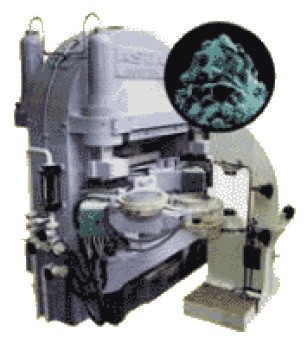
Six-sided top press production process:

The production of synthetic diamond and cubic boron nitride by six-sided top press and process technology is the result of China's complete intellectual property rights and innovations different from other countries. It is the crystallization of the wisdom of several generations of Chinese scientists and engineers and technicians. It is our country. The pride of the superhard materials industry! The six-sided top press and its process method are impressive in the developed countries with the two-face top method. The inexpensive six-face press and its unique method of producing super-hard materials have been able to economically produce world-class products, forcing them to introduce Chinese six-sided presses for research and production.
After half a century of development, the diamond production process has made many new breakthroughs, which are briefly introduced as follows:
Significant progress in low pressure vapor deposition (CVD) technology
The method comprises hot wire CVD and plasma amplifying CVD, which are gases capable of providing carbon atoms such as CH4/H2, CH4/N2 and CH4/Ar, under suitable conditions (such as Si, under low pressure and high temperature conditions). Deposition on c-BN, SiC, Ni, Co, Pt, Ir and Pd, etc., to obtain a high-performance, high-purity diamond film. The following figure shows the equipment of microwave plasma amplification CVD:
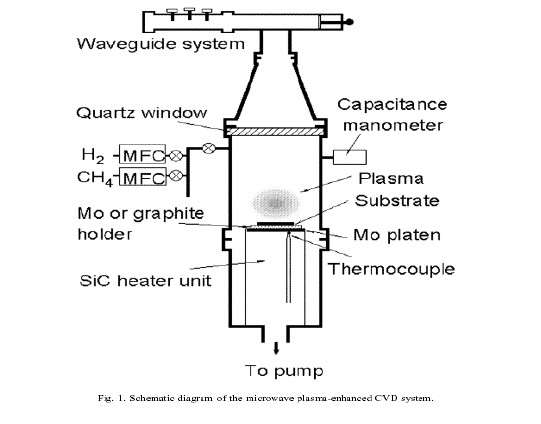
Production of diamond film with C60
According to the British "New Scientist" reported on July 30, 1994, Dieter Gruen of the Argonne National Laboratory in Illinois invented the technology of producing diamond film with C60. This method can be said to be a CVD method. improvement of.
The diamond film produced by the CVD method tends to grow at a slower rate and contains a small amount of hydrogen, which deforms the tetragonal crystal of the diamond, thereby impairing the useful properties of the diamond film. Glenn's new method is to use a high temperature arc between two carbon electrodes to generate soot containing C60 under argon protection, then apply a microwave discharge to the soot, destroy the carbon atom in C60 by discharge, and then carbon atoms. Linked to a dicarbon dimer, this dual carbon dimer is characterized by rapid surface bonding with tools or optical components to form a film close to pure diamond without hydrogen atoms.
Another advantage of this film is that the crystals of the diamond are much smaller than the diamond crystals produced by the conventional methane and hydrogen mixture process, the crystals are ordered nano-sized crystals, and the resulting film is very smooth. The crystal produced by the hydrogen-rich methane mixed gas is a micron-sized crystal.
Production of synthetic diamond from sugar cane alcohol
According to the Brazilian Post, in the world, Brazil produced the first use of sugar cane alcohol as raw material to produce synthetic diamond. The project was developed by the laboratory of the School of Electrical Engineering of the University of Campinas, São Paulo. The units supporting the research of this project include the Brazilian Aerospace Research Institute and other relevant units.
The production of synthetic diamond from sugar cane alcohol is carried out in a special reaction facility. By controlling the pressure and temperature (about 700 degrees), ethanol and hydrogen form a circulation in the reaction facility. Fluorine is added and the ethanol is split into carbon particles. Forming diamond and graphite. Hydrogen and graphite react chemically, and the diamond is attached to the silicon wafer. Chemically remove the diamond from the wafer. In the reaction facility, diamond is grown 10 μm per hour, and 20 g of diamond can be produced with 1/10 L of alcohol. At present, the diamond produced by this technology has high purity, high thermal conductivity and strength, low friction coefficient and natural diamond characteristics. Brazilian researchers also plan to start from a chemical point of view, transforming the process to reduce the diamond growth temperature from the current 700 degrees to 150 degrees. If successful, diamonds can be attached to plastic to produce a diamond plastic glass. This glass has the advantage of being strong and not scratching.
Oxygen-acetylene flame method for synthesizing diamond
In 1988, Japanese scholar Hiroyuki Izumi first synthesized diamond using the oxy-acetylene flame method. The method is simple, economical and practical, and has a fast growth rate, which is two orders of magnitude higher than conventional hot wire CVD and microwave plasma CVD.
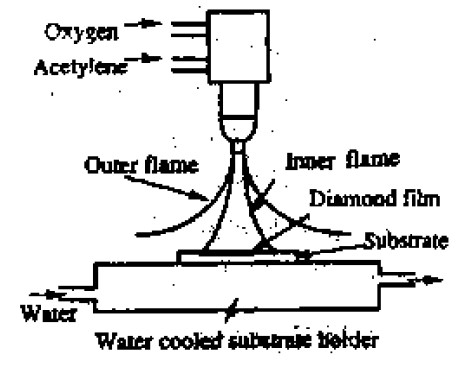
Figure 2 Schematic diagram of the flame method equipment
The structure of the equipment is shown in Figure 2. The industrial use of oxygen and acetylene is used as the gas source. The two flowmeters are used to adjust their respective flow rates, and then enter a certain industrial torch in a certain proportion. The substrate material (such as silicon wafer, titanium) The film is placed on a copper support placed under the torch with cooling water. The substrate temperature can be measured by a photo-Thermometer or a thermocouple. The substrate temperature is generally controlled at 650 to 1050 degrees by adjusting the oxygen valve on the torch. And acetylene valves control their respective flow rates and their flow ratios.
Low temperature reduction of CO2 synthetic diamond
The authoritative academic journal of the international chemical industry, the American Chemical Society, published a paper by the research group led by Professor Chen Ganwang of the University of Science and Technology of China, "Cryogenic Carbon Dioxide (CO2) Synthetic Diamond." The paper describes their major breakthrough in synthetic diamonds (ie diamonds) – the successful synthesis of 250 micron large diamonds using CO2 as a carbon source at 440 °C.
Diamond combustion can become CO2, and the work of scientists at the University of Science and Technology of China has achieved the reverse transformation from CO 2 to diamond for the first time, indicating that there is an unknown internal law in the carbon cycle between the two. This achievement has caused great repercussions in the international arena. The British "New Scientist", the United States "Cutting Tools Engineering" and Italy, France, Germany and other media have reported this, evaluating it as "the idea of ​​gemstones produced in the exhaust gas", "harvesting diamonds from greenhouse gases", "diamonds" From thin air."
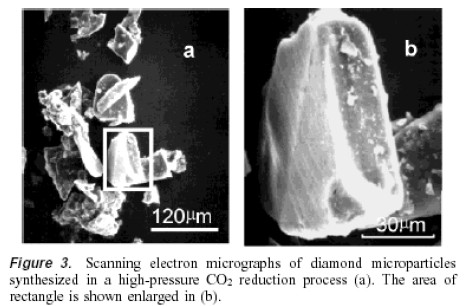
Professor Chen Ganwang and his colleagues developed a high-pressure reactor for experiments. Using safe and non-toxic carbon dioxide as raw material and using sodium metal as a reducing agent, after 12 hours of chemical reaction at 440 ° C and 800 atmospheres, it finally succeeded. The CO2 is reduced to diamond. The yield of CO2 converted diamond is 8.9%, and under the microscope, the beautiful crystals produced can be clearly seen. At present, it has been able to grow 1.2 mm diamond, which is expected to reach the gem level.
Synthesis of nano-diamond powder by explosive detonation
The use of explosive detonation to synthesize nanodiamond powder is a new method for the preparation of nanoscale powders developed in the late 1980s. The usual practice is to use a mixed explosive to detonate in a closed container filled with a protective medium, and the obtained product is a mixed powder of nano-diamond and non-diamond phase carbon, and the non-diamond carbon is removed by chemical purification, drying, etc. to obtain nano-diamond. powder.
Preparation of nano-graphite powder by explosive detonation and synthesis of diamond at high pressure
The nanoparticle powder has the characteristics of small size, large specific surface area, quantum size effect, etc. Its reaction to light, mechanical stress and electricity is completely different from that of conventional size structural particles, so that the physical and chemical properties of the nano material are fundamentally changed. Conventional crystal materials do not have the singular or abnormal physical and chemical properties. Therefore, the use of nano-graphite high-pressure synthetic diamond will be of great significance. At present, the research work of the State Key Laboratory of Metal Materials Strength of Xi'an Jiaotong University has made preliminary progress, using nano-graphite. As a carbon source, on the domestic 6×1200t hinged six-face press, the Fe powder catalyst is used to synthesize the particle size of 5-15 μm, spherical or blocky under the conditions of 5 1GPa and 1250-1330K. Diamond.
They use pure TNT as a bombarding agent. CO2 is a protective atmosphere. Before detonation, the explosion vessel is evacuated (about 200 Pa), and CO2 gas is charged to 105 Pa. The ignition primer is obtained to obtain nano graphite powder. Then, the high-pressure synthesis experiment of diamond was carried out with nano-graphite powder under the action of Fe powder catalyst in a six-face press. The experimental results show that diamond particles are formed in the range of 1250-1330K, and the particle size is 5-15μm. It is spherical or massive. This synthesis temperature is about 300K lower than the temperature of synthetic diamond with ordinary graphite.
Compared with ordinary graphite powder, nano-graphite powder has large specific surface area and small particle size, so that nano-graphite powder and catalyst alloy have large contact area. The surface atomic state of nano-graphite is compared with the internal atomic state of ordinary graphite. The activity is higher, and the number of surface atoms is much larger than that of ordinary graphite. These characteristics of nano-graphite powder may change the conditions of synthetic diamond. From our experimental results, synthetic diamond is synthesized with nano-graphite powder to make the synthesis temperature. Reduced, this is of great significance for saving synthetic synthetic diamond raw materials and energy, reducing equipment technical requirements, etc.
With the continuous development of science and technology in the world, the process of synthetic diamonds is constantly updated. The era of artificial diamond industry monopolized by a few countries (companies) has passed, and the production layout has developed toward multi-polarization. Asia will become the artificial stage of the new century. The diamond industry develops “hot spotsâ€. In the 21st century, a large amount of diamonds will be needed in the building materials, geology, oil and gas, electromechanical, automotive and other industries. The market demand for synthetic diamonds will be more vigorous and the prospects will be more brilliant.
pressure transmitter is a device that converts pressure into a pneumatic signal or an electric signal for control and remote transmission. Pressure Sensor can convert the physical pressure parameters such as gas and liquid felt by the load cell sensor into a standard electrical signal (such as 4~20mADC, etc.), to supply secondary instruments such as indicating alarms, recorders, regulators, etc. for measurement and indication and process regulation.

Pressure transmitters are used in various industrial automatic control environments, involving water conservancy and hydropower, railway transportation, intelligent buildings, production automatic control, aerospace, military industry, petrochemical, oil wells, electric power, ships, machine tools, pipelines and many other industries.
There are two types of pressure transmitters: electric and pneumatic. The uniform output signal of the electric type is a direct current signal such as 0-10mA, 4-20mA or 1-5V. The unified output signal of the pneumatic type is the gas pressure of 20-100Pa.
Pressure transmitters can be divided into force (torque) balance type, capacitive type, inductive type, strain type and frequency type according to different conversion principles.
Our advantageous products are mainly compact pressure transmitters, pressure transmitters with display, differential pressure transmitters, wind pressure transmitters, etc.
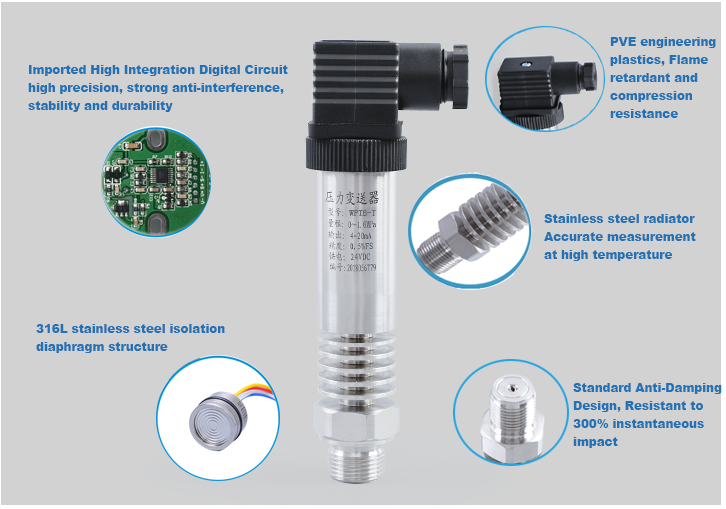
The main advantage
1. The pressure transmitter has the characteristics of reliable operation and stable performance
2. Dedicated V/I integrated circuit, less peripheral components, high reliability, simple and easy maintenance, small size, light weight, and extremely convenient installation and debugging;
3. Aluminum alloy die-casting shell, three-terminal isolation, electrostatic spray protection layer, durable;
4. 4-20mA DC two-wire signal transmission, strong anti-interference ability and long transmission distance;
5. LED, LCD, and pointer three kinds of indicator heads, the on-site reading is very convenient. Can be used to measure viscous, crystalline and corrosive media;
6. High accuracy and high stability. In addition to the imported original sensor that has been corrected by laser, the comprehensive temperature drift and nonlinearity of the whole machine within the operating temperature range are finely compensated.
Pressure Transmitter,Pressure Transducer Sensor,Digital Pressure Sensor,Pressure Transmitter 4-20Ma
Wuxi Winsun Automation Instrument Co., Ltd , https://www.jswxwinsun.com
